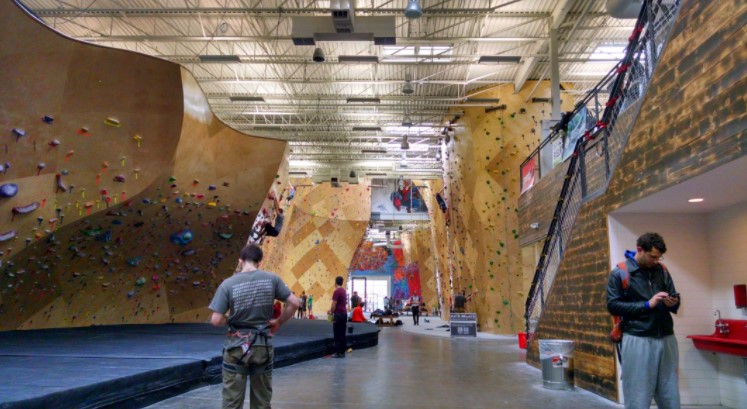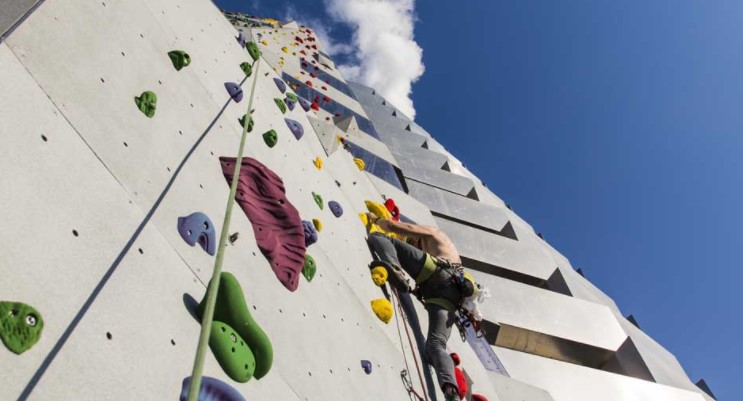Are you an avid climber eager to discover the maximum heights climbing walls can reach? Or maybe you’re simply curious about climbing, thinking about giving it a try, and wondering just how tall climbing walls can be before you begin? If so, keep on reading as we dive into everything there is to understand about climbing walls, especially their heights.
A climbing wall is a specially designed wall for climbing and is often built to stimulate a rocky surface.
It is an artificially manufactured wall with grips, made for hands and feet, designed for indoor climbing exercises, and sometimes for the outdoors.

Some climbing walls are wooden, while some are made using thick multiplex boards. Recently some climbing walls are made with aluminum and steel. A regular climbing wall has places to attach ropes called Belay Ropes. And is also used to practice other exercises like bouldering, etc. All this is to show that most climbing walls are made to imitate a real outdoor rock.
Climbing walls were originally built to ensure that rock climbers could train and continue in their practice during unfavorable weather where climbing was difficult and assessments were hard. Indoor climbing has gained popularity over the years, a lot of it.
And this has resulted in so many people beginning the art of climbing walls. But that’s not all, a lot of people use it for amazing opportunities like; meeting new people, hanging out with friends, or getting climbing training.
Climbing was included in the 2021 Tokyo Olympics for the first time, and there are participants of the sport who no longer climb outside or have never done so.
Climbing walls vary depending on their use; from a mini house facility to massive walls found in old buildings and desecrated churches or places. And now there are centers, especially for bouldering and wall climbing. Indoor climbing is a social exercise and these walls are great avenues to connect with new people and hang out. The mood of the entire workout, the adrenaline, and the vibe around climbing walls with its participants make it the ideal sport. Some larger climbing facilities even have cafes, which boosts the sociability of the sport and makes it more pleasurable.
Outdoor climbing on the other hand is the literal opposite of indoor climbing and this is best known as rock climbing. According to Wikipedia, Rock climbing is a sport in which participants climb up, down, or across natural rock formations or artificial rock climbing walls. The goal is to reach the summit of a formation or the endpoint of a usually pre-defined route without falling.
Types Of Climbing Walls
Climbing is an activity practiced every day in various parts of the world and this has led to the invention of varying types of climbing for different purposes. Generally assumed is the notion that there are only two or three different types of climbing; Lead climbing, bouldering, and mountaineering but there are more than three types of climbing with these three as their primary types:

- Bouldering: Bouldering is a sort of climbing that doesn’t demand a rope and may be performed unassisted. It involves climbing up and over rocks at relatively low heights without utilizing ropes.
- Highballing: Highballing is like bouldering except riskier due to the fact that the maximum height is around 15 feet. Climbing a wall or rock between 15 and 40 feet without a rope is what we call highballing. Highballing is done on a rock but the interesting thing is that you rarely ever find a highballing climbing wall.
- Lead Climbing: Lead climbing is a climbing style used mainly in rock climbing. It’s a roped party where one climber has to take the lead and fellow climbers follow. The lead climber wears a harness attached to a climbing rope which in turn is connected to the climbers below the lead climber.
- Free-soloing: Free soloing doesn’t require any ropes and is a very dangerous type of climbing. No kidding! It has quite a number of deaths to its name. Free-soloing is the advancement of bouldering. It is climbing without ropes to a height above 40 feet.
- Mountaineering: Mountaineering is also known as mountain climbing and has a number of distinct names. It’s comparable to fitness hiking, but just that the tactics used to ensure that paths are securely navigated, make it physically more challenging. Mountain climbing is mostly done in groups because teamwork and support are important and necessary in aiding safety.
What Is the Height of Climbing Walls?
You know what a climbing wall is, you’ve read about the types of climbing, you’ve read about the types of climbing walls (Kids climbing wall, Climbing Gym wall) and now you question just how high these climbing walls are. If you’d like to try climbing and you’d like to know just exactly how high a climbing wall is, then read on but the height of these walls depends on the type of the walls. Climbing gyms, sport climbing, and indoor climbing walls all have different measurements.

Minimum Height
We climb walls based on the usage of the wall. The height of a bouldering wall is different from the height of a lead climbing wall or a top rope and thus the minimum height differs.
Bouldering walls are at least two feet high, as this allows you to move a bit before you reach the top of the wall.
Top rope walls are generally 20 feet high at least but shorter top-rope walls exist a typical top rope wall is taller as top-rope climbing walls range between 30 to 40 feet high.
For lead climbing walls, the shortest is at least 25 feet as lead climbing walls tend to be taller due to how dangerous they are when the climber is close to the ground with a higher risk of falling to the ground. A good lead climbing wall is about 40 feet taller or more to allow for movement and safety.
Climbing walls have average length but over the years keep getting taller with no maximum height in sight and there’s no one to answer how high climbing walls are on average. Top-rope and lead climbing walls are around 40 to 60 as earlier started bouldering walls between 15 to 20 and remember that the range in height differs. It isn’t about height alone, because if a climbing wall has good routes and is designed perfectly, it makes the whole experience worthwhile.
